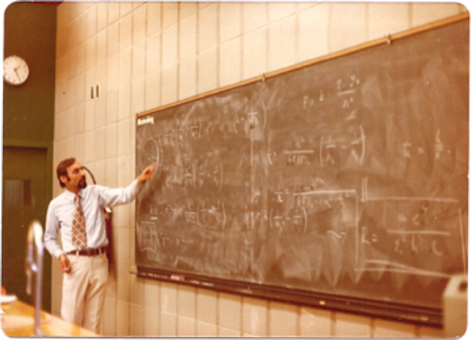




Above: George Brown College logos from the 70’s until today.
N.B.: Math and Science Department ceased to exist in the early 90’s.
Below: Atomic Physics for Electronics and Instrumentation Technology in C505
DEPARTMENT of MATHEMATICS AND SCIENCE
In December 1974 I was employed by the Academic Studies Department of George Brown College to teach Science and Engineering subjects and became a full-time professor after two years of on the job training and certification.
The Department of Academic Studies was located on 160 Kendal Avenue, on the fifth floor of the C building of the Casa Loma campus. The office and the adjacent staff room accommodating over 40 full-time faculty were located in room C511. The Academic Studies Department was chaired by John Muma, who headed the section of English and Liberal Studies, whereas the Math and Science section was headed by the Assistant Chair, Jack Hague.
Academic Studies was a “service department” with no programs of its own, offering academic subjects to the Electrical Department, located on the same floor in C 526, chaired by Harry Moradian, The Architectural Department, on the third floor, chaired by Brian Beatles, and the Mechanical Department located in the A Building (later demolished to make room for the Blue Moose on 37 Dartnell), chaired by Ed Winchuk. It also offered academic courses to the HVAC Department (e.g. Thermodynamics) located on the second floor of the C building, Physics and Chemistry courses including labs (in the C building) to the Nursing Programs in Health Sciences Department located in the B building, as well as basic math to apprenticeship programs (Sheet Metal, Stationary Engineers, etc.) in the D building at 1 Dartnell. The Dean of Academic Studies who interviewed me, Howell Pritchard, later became Vice President Academic, replaced by Dr. Bob Gwillam, who became the Dean of the new Math and Science Department and Director of Research and Planning. In 1990, Jack Hague was seconded to the late College president, Doug Light, to research the effectiveness of College departments. According to Mr. Hague, based on his suggestion, the Math and Science Department was closed down. I elected to join the CAD/CAM Department, headed by Richard Smith, later converted to the Computer Science and Engineering Department, chaired by Hilde Zimmer (who only a few years earlier was the GBC president of OPSEU)...
In the late 70’s Apple II became my favourite microcomputer. In fact it was the first user friendly microcomputer on the market, commercialized in 1977. Throughout the early 80’s, while being the Coordinator of Energy Conversion Technology, which I developed, I was consultant in the Staff Computer Training Centre, coordinated by Brenda Bennett-Smith. I built several AppleII+ clones (when it was not yet illegal), and held seminars and workshops in the College’s auditorium, C316, on how to build them. - After IBM released their own first microcomputer in 1981, I also gave workshops on “Building your own IBM Compatible”, which was never illegal, and which is why such IBM Compatibles as Compaq, Dell, Toshiba, Sony, Acer, and the like are in existence. It’s interesting to note that initially there were many Apple II clone makers worldwide. In Canada, one could buy less expensive Apple II clones like Franklin, Peach, Pineapple, Zeus, or the canadian Mackintosh (?), but as soon as these clones became slightly successful, Apple legally "put them out of business". - Also interesting is that in 1984 Apple released their first successful mouse controlled CGI computer under the name Macintosh (no "ck"), later called Mac Classic.
In 1979 Commodore PET (Personal Electronic Transactor) became mainstream in schools, again mostly because it was less expensive than AppleII+. As a result, in 1979, with two other faculty members, Fred Mitchell and Dr. James G. W. Carswell, I developed the very first microcomputer course, Programming in Basic, and started teaching it in the very first computer lab at GBC, in C441, equipped with Commodore PET computers.
In the same year I became a Science Coordinator at St. James Campus, and proposed a new three year program in alternative energy, which was implemented in 1981 as the only program within the Mathematics and Science Department, entitled: Energy Conversion Technology.
EMPLOYMENT
Started: December 4, 1974
Age at Start: 32 years old
Position: Teaching Master/Prof.
Status: Certification after
2 years on the job training
Subjects:
Mechanics, Mathematics
Physics, Modern Physics,
Chemistry, Thermodynamics
Strength of Materials
For more see: ECT
TEACHING
1974 - 1980
Faculty of: Academic Studies
Room C511
160 Kendal Ave
Toronto, Ont.
Programs:
Electrical Technician
Electrical Technologist
Electronics Technician
Electronics Technologist
Instrumentation Technologist
Tool & Die Technician
Graphic Arts Technician
Offset Printing
Stationary Engineer
Sheet Metal Worker
Land Surveying Technician
Carpentry
HVAC Technician
HVAC Technologist
Nursing
Prosthetics
Plastic Mouldings
Pre-Technology
Pre-Health
LOCATIONS
Casa Loma Campus
St. James Campus
Kensington Campus
Cherry Street Campus
St. Joseph’s Hospital
Toronto General Hospital
Ryerson Polytechnic Institute
TEACHING PHILOSOPHY
I teach what I practice
Primary Objective:
Motivate students to learn
Important Learning Factors:
Discover what you like;
if you do what you like
it won’t feel like work
Persist (never give up)
Gain bird’s eye view -
don’t get lost in the bush.
Synergize - work with others
Volunteer to teach,
it’s the best way to learn.
Vitamin C- build connections
e.g. become member of a club,
give presentations at meetings
Learn while you work,
i.e. develop professionally,
Stay On Top:
Write papers for magazines &
Present at conferences